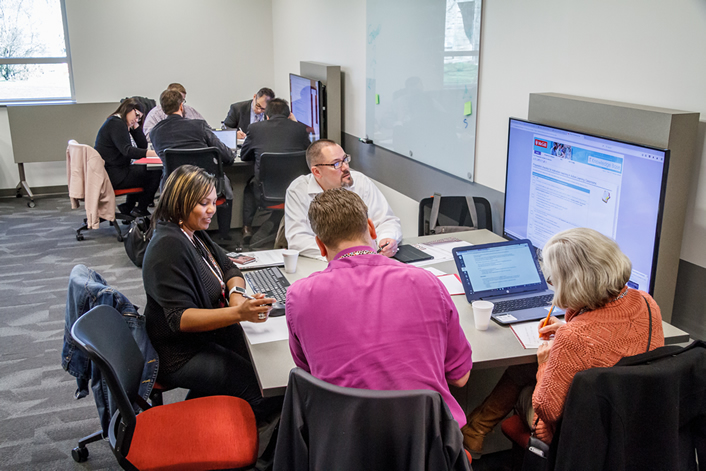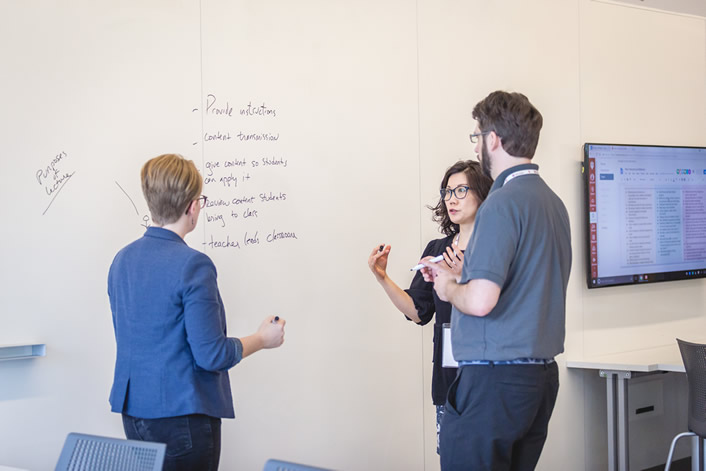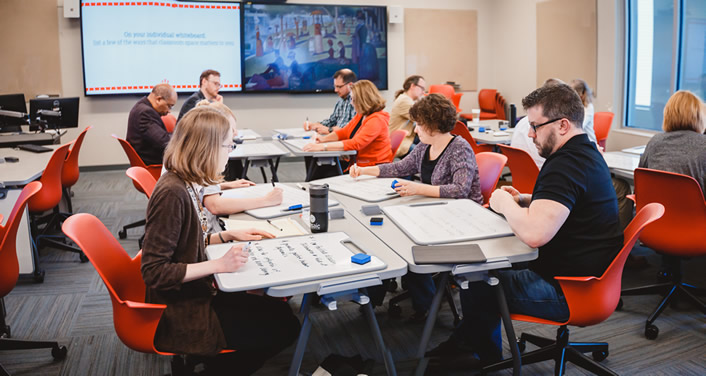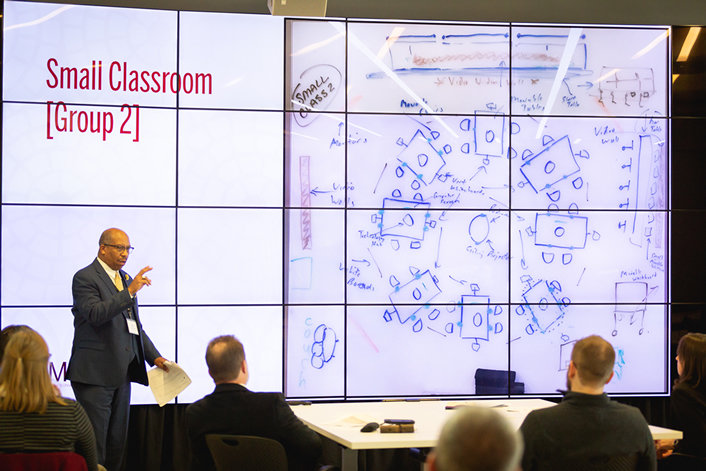Indiana University's Mosaic Fellows program has upended standard practices for many faculty development programs in ways that have given faculty members a significant voice in the growing conversation about learning spaces and pedagogy.

Indiana University's Mosaic Initiative supports innovative classroom design, research, and active learning in all Indiana University (IU) classrooms. As program director of IU's Mosaic Initiative, I lead efforts to support those goals. A key part of the Initiative is the Mosaic Faculty Fellows program, a one-year experience that introduces faculty to teaching and researching in active learning classrooms.
The Mosaic Faculty Fellows program has anchored the broader Mosaic Initiative. Ideas developed in coordination with and by the Mosaic Fellows continue to influence teaching and classroom design throughout our seven-campus system. The steady influence of the Faculty Fellows program on the larger Initiative obscures the ever-evolving nature of the program. When I look back on what was intended for the Mosaic Fellows program at its creation and how it evolved, I'm struck by how it has upended standard practices for many faculty development programs in ways that have given faculty members a significant voice in the growing conversation about learning spaces and pedagogy across IU.
Emphasizing Faculty-Led Active Learning
Starting in 2016, cohorts from our Bloomington and Indiana University–Purdue University Indianapolis (IUPUI) campuses began their tenure as our inaugural Mosaic Fellows. During the program, Fellows visited a variety of classrooms across their respective campuses, collaboratively explored active learning activities, read foundational literature on active learning classrooms, and advised our learning spaces team on new classroom designs.

(Photo by Alicia Hosey, Indiana University.)
By spring 2017, the first Bloomington and IUPUI campus cohorts of Mosaic Fellows were concluding the one-year program. As the end of the program approached, many Fellows expressed a desire to remain Fellows in some capacity. These faculty members worried that they would lose their voice in the ongoing conversation about learning spaces at IU. To stay involved in the community, many Fellows even asked if they could reapply to the program!

(Photo by Emily Sterneman, Indiana University.)
As more Fellows requested to preserve their place in the community, I realized I needed to reconsider the length of the one-year program as well as if and how faculty members could remain involved once they completed the program. The solution would require more than extending the program to a second (or third or fourth) year. The Fellows didn't just want to keep meeting, they also wanted to take on new roles. They wanted to mentor future Fellows, develop research projects, and give more feedback on learning spaces. Most importantly, they wanted to share what they had learned with the broader IU community.
Expanding Roles in a Broadening Community
The Fellows' passion for continuing to work with the Mosaic Initiative inspired me to create the role (and title) of Senior Fellow. This new role would provide a platform for future work in the growing active learning classrooms community. Now, when Fellows "graduate" from the one-year program, they have the option of moving into this role so that they can continue to participate but do so in ways that are more focused on mentoring, sharing, outreach, research, and informing future classroom design.
Senior Fellows share their experiences during research webinars and active learning workshops, and through blog posts, publications, and presentations. They engage with and build the active learning community through participation in reading groups and subject matter subgroups. Senior Fellows also serve on their respective campuses' learning spaces committees and continue to give feedback on new spaces across IU.

(Photo by Emily Sterneman, Indiana University.)
In shaping their new role, the Senior Fellows did more than continue their involvement in the Mosaic Initiative—they transformed the program itself. They now participate in the Mosaic Institute (the first, formal gathering of new Fellows) and at least one Fellows program session. We currently have seven cohorts of Senior Fellows and host events to which all Fellows are invited, allowing for even broader faculty collaboration across our seven campuses. New Fellows begin the program knowing that they are joining an established and growing community where they can continue to be involved even after their initial one-year tenure comes to a close.

(Photo by Emily Sterneman, Indiana University.)
Kalani Craig, a clinical assistant professor in the Department of History and co-director of the Institute for Digital Arts & Humanities at IU's Bloomington campus, described her experience as a Senior Fellow:
After working closely with other teachers interested in structuring the same kinds of hands-on learning work, and honestly getting to work in some of the amazing Mosaic classrooms at IU-Bloomington, it seemed strange for those connections to just end. Having the option to stay and remain involved with Mosaic (as a Senior Fellow) at professional conferences, on campus strategic planning committees, and with new Mosaic cohorts gave me the chance to expand on what I learned in that first year. Instead of leaving one community behind, it meant becoming part of several new communities that all overlapped.1
Keys to Rethinking Faculty Development
The Senior Fellows continue to inspire me to rethink classic approaches to faculty development, such as the traditional one-year length of most faculty programming. As of this writing, Senior Fellows are continuing to advocate among various stakeholders and shaping the future of learning spaces across Indiana University in the process.
If you are trying to create a faculty cohort on your own campus and are interested in building one that evolves and grows past the initial one-year program, here are my words of advice:
- Give them a title. We gave the Senior Fellows a title to indicate their new role. The title signifies the work they have accomplished and the new position they occupy. Several Fellows use their titles in their email signatures, faculty bios, and tenure portfolios. The fact that Fellows use the titles suggests that they see the new role as important and that other stakeholders do too.
- Provide both continued and new types of support. We offer Senior Fellows new opportunities to engage with one another. Senior Fellows have access to different types of assistance, such as specialized research support, including a research grant to further projects they began as Fellows. Senior Fellows also continue to have access to our faculty development offerings, including in-classroom consultations and other support.
- Enable voluntary participation. Once Fellows graduate, they're under no obligation to continue with the Mosaic community. Most of these faculty members still engage with us; however, they often ebb out of and back into the community as commitments allow. The freedom from obligation enables Fellows to choose how and when they wish to participate with us.
By inspiring a new, still-evolving role in the broader Mosaic Initiative, the Senior Fellows have fashioned themselves into a critical mass of faculty who are contributing to institutional change at Indiana University. It's exciting to consider how educators can reshape faculty development efforts on their campuses in order to facilitate important conversations and relationships and, ultimately, to support a sustainable approach to transforming teaching and learning.
Note
- Kalani Craig, email message to Tracey Birdwell, April 28, 2019. ↩
Tracey Birdwell is Program Director for the Mosaic Active Learning Initiative at Indiana University.
© 2019 Tracey Birdwell. The text of this work is licensed under a Creative Commons BY-SA 4.0 International License.
